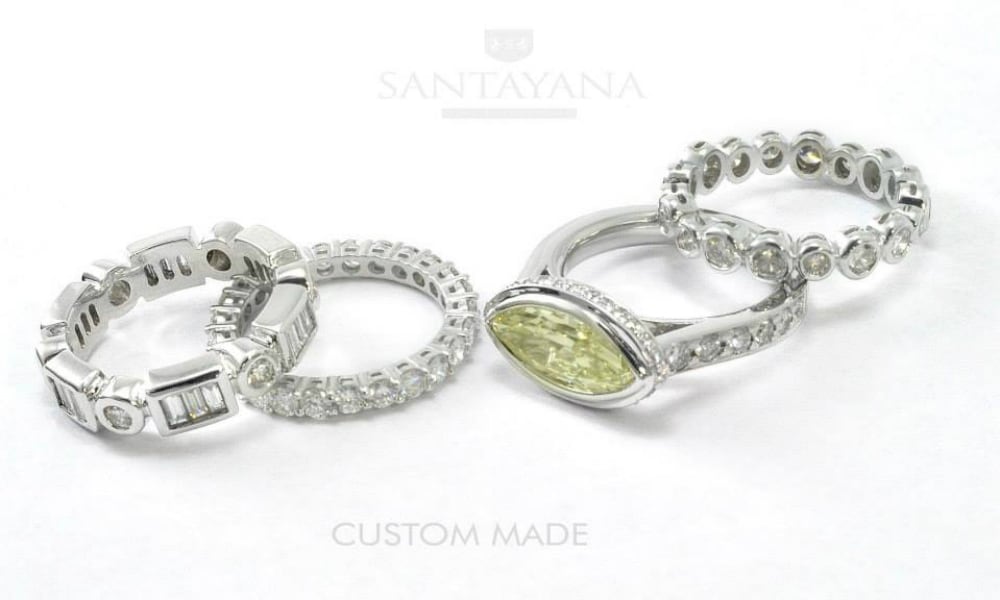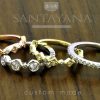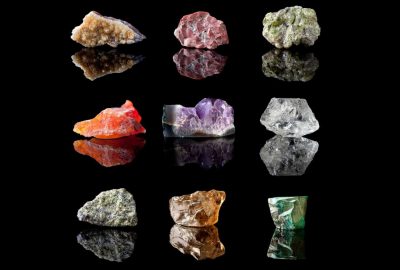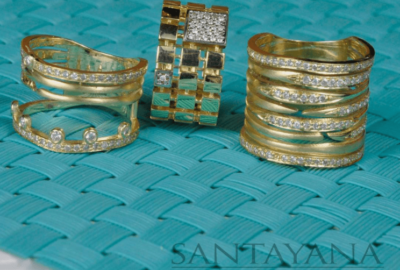Industry News
“Diamonds are intrinsically worthless, except for the deep psychological need they fill.”
-De Beers Chairman Nicky Oppenheimer
It’s Valentine’s Day – and everyone, single or paired, is thinking about love. And what’s more inextricably linked with love than money? No — seriously. Take a minute to think about that…
What’s more synonymous with love than an engagement ring? What’s more synonymous with romance and diamonds? Have you ever wondered how that happened? I did. It turns out diamond engagement rings are not a timeless tradition as we’ve been led to believe. They were a marketing tool invented by an advertising agency in the early 50s to sell the surplus of small, colorless (i.e. worthless) diamonds that De Beers had hoarded and then found it couldn’t unload.
This isn’t a hate on romance, or jewelry. I love both. This is just the story of a story. In fact, it’s the story of two stories. One is the story of the very first diamond engagement ring, given to the Princess Mary of Burgundy by Archduke Maximilian when he proposed in 1477 AD.
The second story occurs half a millennia later, when De Beers, having consolidated 99% of the diamonds on earth, convinced the entire, previously indifferent world that everybody wanted a diamond, and always had. This is the story of how De Beers pulled off one of the greatest con jobs in history, and built a multi-billion dollar empire as a result.
Will You Merger Me?
In 1477 AD, 18-year-old Archduke (and later Holy Roman Emperor) Maximilian proposed to his great love, Mary of Burgundy, with the first ever faceted diamond engagement ring. Thus the two lovers began the swoon-worthy tradition of the diamond engagement ring; a tradition that has persisted, in an unbroken procession of promises, sparkles, and kisses for the last 534 years. Sigh…
Well, that’s De Beers version, anyway.
The Archduke did in fact propose, (through emissaries and ambassadors) to Mary of Burgundy in 1477—even though he’d never met her, and probably couldn’t have picked her out in a line-up. He did present a faceted diamond engagement ring…to her father, Charles the Bold. That part of the story is true. It wasn’t the kind of Tiffany’s, diamond solitaire you might be picturing. The diamonds were tiny, and set into the shape of an ‘M.’
Supposedly it was an ‘M’ for Mary—although it could just as easily, and even more aptly, been an ‘M’ for monarchy or am ‘M’ for money. It really should have been ‘M’ for merger. The marriage was actually an elaborate, multi-national land deal, as royal marriages often are. The diamond ring was a well thought-out and heavily loaded symbolic gesture of the most public kind.
The diamond engagement ring, as we all know it, was an invention of De Beers and a New York advertisement agency, N.W. Ayers. It was, first and foremost, a product. But it was a new kind of product. It was a way to emotionally compel people to buy diamonds, by reinventing the idea of diamonds as necessities, rather than temptations or frivolities. It was also a way to unload those diamonds on the biggest new market in the world. Even if it was also the market least interested in having them. Finally- it was a way dress up and present the smallest, least desirable stones, as though they were something special and important.
So how did they do it? First they invented, or at least sensually massaged, an origin story; they settled on the exchange of the “first diamond engagement ring” between Maximillian and Mary. They mined history for a precedent, and made it the center of an epic spin campaign. The story of “the first diamond engagement ring” set just the right romantic tone, and just the right epic historic context.
Then they did something really creative: They hired Madison Avenue ad firm, N.W. Ayer, to sell the idea of diamond engagement rings to an unwitting public, particularly the under-18 crowd.
De Beers already had the scarcity angle covered by manipulating the supply, to such a degree that diamonds were already considered rare and thus very valuable. All that was left was to manipulate the customer.
In 1948, N.W. Ayer created the iconic campaign: “A Diamond is Forever.” They engaged in cutting-edge techniques, like product research and social psychology. They employed, if not invented, product placement way ahead of its time; they gifted movie stars with diamond rings, then paid paying multiple media outlets to show them wearing the rocks.
De Beers didn’t invent the diamond engagement ring. They did one better. They invented the myth of the diamond engagement ring.
Everything You Never Wanted To Know About Diamonds
What is a diamond, technically speaking?
In scientific terms, a diamond is an allotrope of the element carbon, meaning that it is one of many forms a substance might take. Other allotropes of carbon include coal, soot, and graphite, more commonly called pencil lead.
Carbon is a component of almost everything. It’s certainly a component of you. 99% of the human body is made up of only three elements, and one of them is Carbon. It’s also major component of the atmosphere, the oceans, and every organic (i.e. carbon-based) life form on the planet. To say carbon is common would be an understatement. It’s the fourth most abundant element in the universe.
All the diamonds on earth and underground were formed about 320 miles below the earth’s surface, 1 to 3 billion years ago, under intense heat and pressure. There is no doubt an almost inconceivable amount of diamonds are still down there. The diamonds that we mine or find near the surface were carried up to the earth’s crust by kimberlite pipes, the “roots” of certain small, and super powerful volcanoes that reach three times deeper into Earth’s mantle than larger volcanoes like Mount St. Helen’s. Millions of years ago, when those volcanoes erupted, diamonds were carried upward in the magma, and deposited among the other rocks.
Carbon actually comes from the Latin word Carbo, meaning Coal. Diamonds are in fact, just a really, really compressed form of coal.
Fancy, huh?
At standard temperature and pressure, carbon will take the form of graphite. In graphite, each atom is linked to 3 other carbon atoms, all of them linked together, in a 2-D sheet of fused hexagonal rings. Confused? Imagine a chain-link fence lying on the ground; each place where the chain crosses is an atomic bond. If you layer one chain-link fence on top of another, on top of another, in loose sheets, that’s graphite.
So what makes some generic carbon a diamond and not a sheet of graphite? Organization. Under very, very high pressures and temperatures carbon atoms will form a more well-organized version of the same thing. Each of those layers of chain-link fence is linked to each other vertically as well, at every cross point. Like stacked cubes, stuck together at each joint, a diamond’s lattice is symmetrical in every direction. This pattern gives the mineral all of its properties, most famously its ability to scatter light waves like a prism. When light enters a diamond, the incredible density of electrons forming that cubic crystal lattice scatters the light waves, breaking them apart (into colors) and causing them to bounce around.
This isn’t just pretty, it’s perfect, at least from a molecular standpoint.
That does not, however, make them rare. In 1998, there were approximately twice as many diamonds in circulation as there had been fifteen years before that. And there have been massive new finds since then. GIA estimates an accumulated total of 4.5 billion carats of diamonds have been mined just since the beginning of the South African diamond rush. That’s enough diamonds to provide every single one of the approximately 7 billion people on the planet with a standard one half carat diamond ring—with a billion carats left over.
Nor do diamonds last forever, despite what their many advertisers would have us believe. The word diamond comes from the word adamantine, meaning indestructible. And while it’s true that nothing can cut a diamond except another diamond, that doesn’t mean nothing can destroy them. In fact for an item which bases its reputation on its strength and timelessness, diamonds are aren’t really that durable. Hard, yes: the hardest substance in the mineral family, and more than 50 times harder than the next hardest, sapphires. But hard isn’t the same as strong.
You can do all kinds of terrible things to them. You can scratch them up in your jewelry box as long as you have other diamonds, you can actually incinerate them at 1400°- no joke, they just vanish—not a trace is left behind. Or, if you’re like my curious six-year-old father, having heard that diamonds are the hardest substance on the earth, you can take your mother’s one and only diamond ring and smash it to bits with a hammer. (It was a trauma from which she apparently never fully recovered).
Diamonds are not only brittle, but quite thermodynamically unstable. Right now, as you read this, every diamond you’ve ever seen is slowly converting back to graphite. The process is just so incredibly slow at room temperature that human beings will never live to see it.
So— who wants coal in their stocking this year!? (Because that’s all diamonds are made of.) The answer, apparently, is everyone- as long as they don’t know the real substance of what they’re getting. Generally, people don’t. And there’s a good reason for that: No one in the last 80 years has sold a diamond – they’ve sold an idea.
And God only knows what ideas are made out of…
Can’t Buy Me Love
Oh wait—yes, you can. At least, according to De Beers you can. They’ve spent the last half a century convincing the world that a diamond is synonymous with love. Not everyone wants a diamond, but everybody wants love. The best thing about love, as a seller’s commodity, is that it’s free—so the profit margin is spectacular!
There’s a reason that linking diamonds with the idea of love was so completely successful. Love and money share the same real estate in your brain. Researchers in a relatively new field called neuroeconomics are studying just that. They are looking, not just behaviorally or chemically, but actually structurally, at the way your brain values things. And a team at Duke University finally found the sweet spot. It’s called the ventromedial prefrontal cortex (vmPFC), it’s a few centimeters in, right between your eyes.
So what happens in this special V-spot?
You value things. You also love things. They’ve actually discovered that “the processes that determine emotion and value both take place in the ventromedial prefrontal cortex. “ That means the process by which you feel an emotional attachment, and the process by which you determine a thing’s worth, are all bundled up in the same little cluster of neurons.
Clearly, wires get crossed.
Everyone’s always known that making someone feel good is an effective way to make them part with cash, whether that’s a charming salesman, or an ad with a smiling baby- But that’s just anecdotal. Now, with the identification of the vmPFC’s action, we know why, and where, and how. According to Dr Scott Huettell, of the Center for Interdisciplinary Decision Science at Duke University, it has been well established that judging value and emotion happen independently in the cortex, but until this breakthrough, no one had found the physical link between the two.
Well, De Beers must have had an inkling…
Diamonds aren’t forever. Diamond engagement rings have only been a “necessary luxury” for about eighty years. The truth is: diamonds are neither rare nor intrinsically valuable. What value diamonds do possess is largely created in the minds of the consumer. We take the tradition of a diamond engagement ring for granted, as if it were as old as marriage itself. It is not. In fact, it’s only about as old as the microwave oven.
Through a clever combination of pioneering market research, advertising, and product placement, De Beers has bedazzled us so thoroughly that we all believe this myth is not only true, but always has been. In fact, the myth is so compelling that it justified the sale of a product De Beers couldn’t unload, to a population who didn’t want it.













































Leave a reply